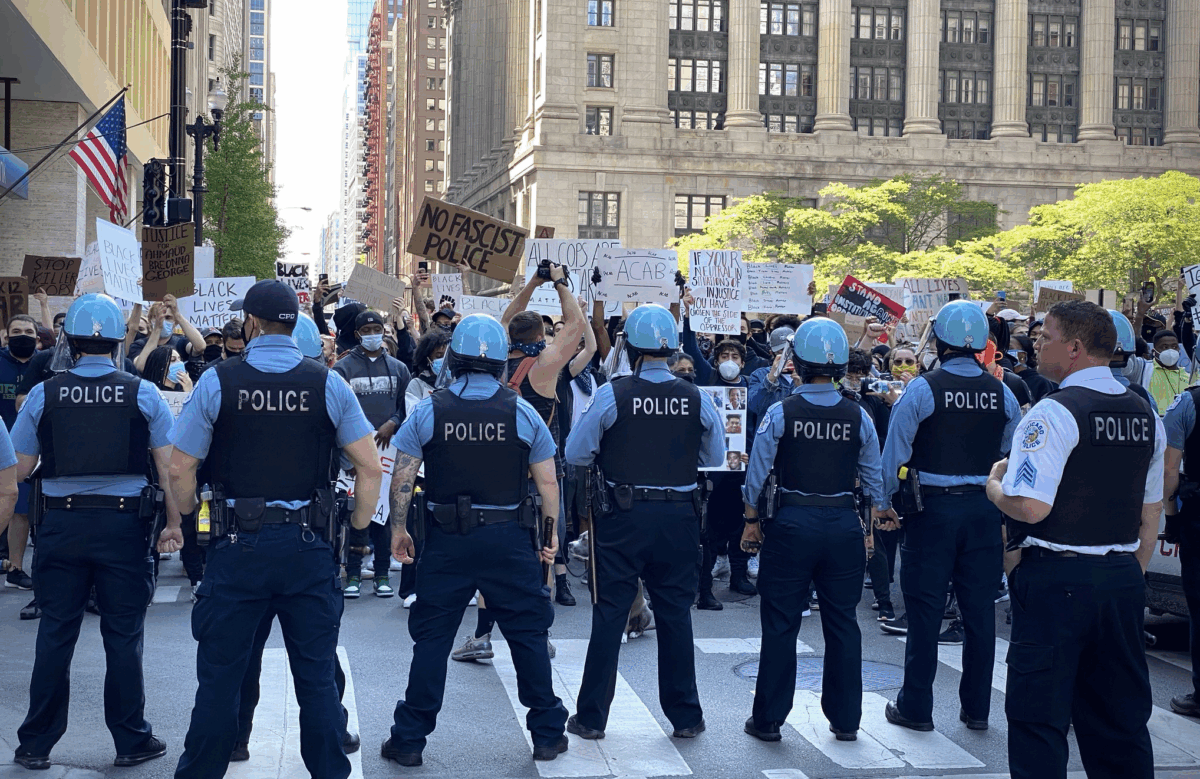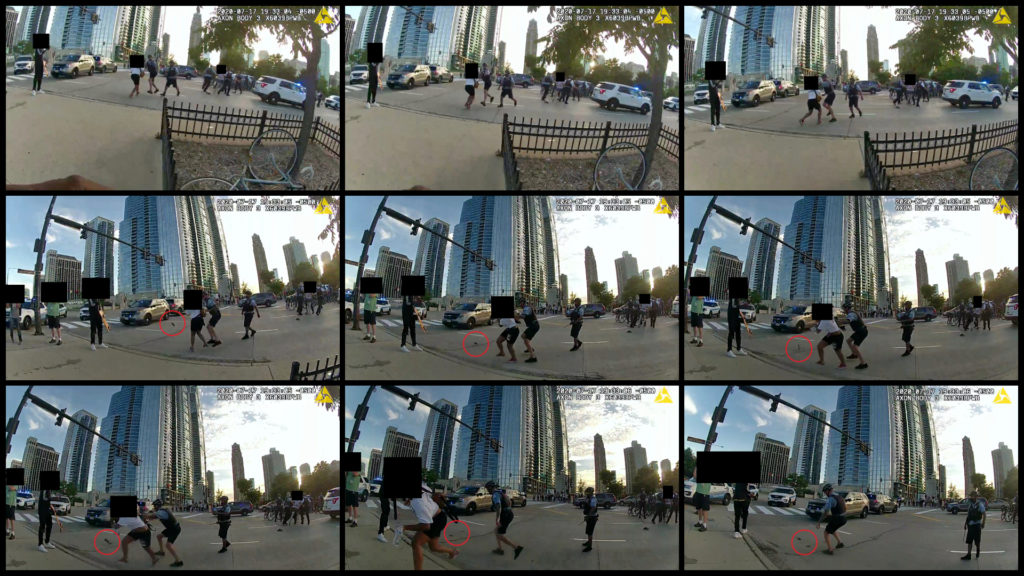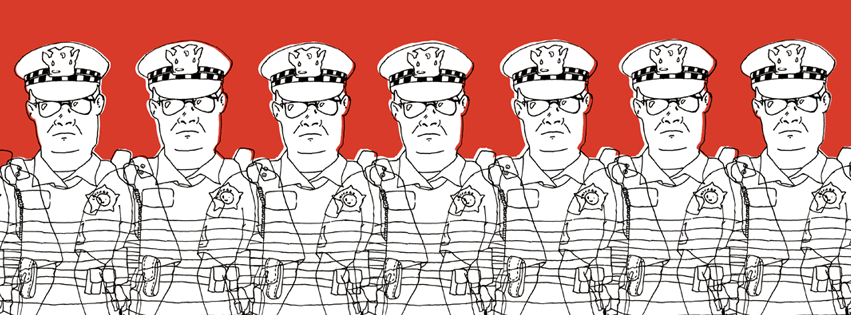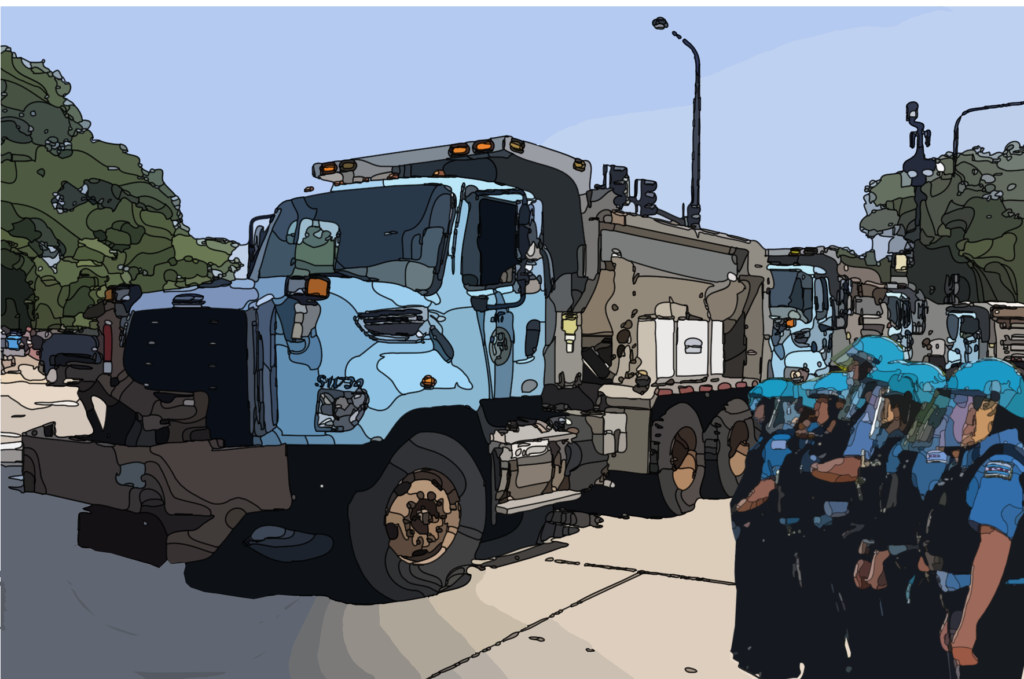At a press conference near the lake on the Friday before Memorial Day 2020, CPD Superintendent David Brown announced the launch of the Summer Operations Center (SOC), a multiagency gun-violence prevention hub. Brown said the center had a singular mission: “Reducing murders and shootings this summer.”
But internal documents obtained through dozens of Freedom of Information Act requests show that almost immediately after the SOC’s creation, with the onset of citywide protests against racism and the police murder of George Floyd, the police department began using the violence-prevention center to monitor and share intelligence about political demonstrations. The police continued to use the SOC to surveil political organizing throughout the summer and fall—even going so far as to quietly add protest monitoring to the center’s stated mission.
Gun violence typically increases during summer months in Chicago. Under Superintendent Brown, who joined CPD in April 2020, violence prevention became the departmental watchword. The SOC—modeled on the department’s district-level surveillance hubs, called Strategic Decision Support Centers—was central to that mission.
The SOC was housed in the Office of Emergency Management and Communications (OEMC) headquarters in the West Loop, and was staffed by employees of the CPD, the Department of Business Affairs and Consumer Protection, the Chicago Transit Authority, Streets and Sanitation, the Chicago Housing Authority, the Chicago Park District, and other agencies. A May 20, 2020 letter from OEMC to agency heads described the SOC as a “partnership with CPD and the Mayor’s Office…over the summer to support citywide coordination around violence reduction.”
The center operated overnight every Thursday through Sunday from May to October, with interagency briefings each evening. Notes from the welcoming statement for the SOC’s first evening briefing on May 23 said the center’s purpose was “a coordinated effort across all city resources, using geographic and crime analytic procedures in deployment of city resources to promote the reduction of violence.”
To achieve that, SOC briefings reviewed intel on recent shootings and planned violence-suppression missions that blanketed target areas with surveillance technology such as license-plate readers, gunshot sensors, and thousands of video cameras, as well as sending “surges” of CPD personnel and police cruisers with flashing lights to strategic locations across the South and West Sides. How successful these efforts were in preventing gun violence, which reached historic levels in 2020, is unclear.
What is clear is that the CPD also used the Summer Operations Center’s wide-ranging surveillance apparatus to monitor political organizers and plan missions to police demonstrations all summer.
On May 25, then-Minneapolis police officer Derek Chauvin murdered George Floyd, and a widely shared cell-phone video of the killing sparked protests and uprisings in cities across the country. In Chicago that Saturday, helmeted police escalated confrontations with demonstrators by attacking them with batons and chemical irritants. Police cars were soon set ablaze. Hoping to protect businesses in the Loop, the City raised bridges and suspended bus and train service. That evening’s SOC briefing included a “Protest Update” that outlined how traffic and bridges were being shut down and noted that “multiple arrests” had been made.
Around the same time as the evening briefing, someone at the SOC sent police officers and Department of Business Affairs and Consumer Protection (BACP) inspectors to the Chicago Freedom School. The SOC sent the inspectors there because the school opened its doors and ordered pizza for youth who were trapped in the Loop amid the evening’s chaos. “The allegations were that they were providing shelter and preparing and distributing food to the protesters,” wrote Ivan Capifali, a deputy commissioner at the BACP, in an email to CPD Commander Mark Harmon. “The request came from the Summer Violence Reduction Center (SOC) which BACP is also a part of.”
At the next day’s morning briefing, the SOC’s mission had changed: it was now, “Continuing a coordinated citywide response to any demonstrations.” The briefing laid out the CPD’s “outer perimeter footprint” designed to protect the “Central Business District.” The City’s gun-violence prevention center had been operational for just one week before it trained its gaze on political dissent.
The CPD—and by extension, the SOC—likely found out that the Chicago Freedom School was sheltering protesters by monitoring social media. At a press conference in August, Superintendent Brown announced the department was expanding its “capacity of looking at intelligence” (i.e., public social media posts) to prevent looting, but internal records show the social media task force actually began operating weeks earlier. Detectives and patrol officers assigned to the unit worked round-the-clock trawling Facebook and Twitter for signs of unrest: CPD records show at least ten cops earned overtime while monitoring social media last year. The intelligence they collected was shared with other agencies via the Summer Operations Center. SOC briefings eventually included detailed reports from the social media unit on the timing, locations, and number of people who had responded to public event announcements.
In the weeks following the May 30 rebellions, the SOC continued to coordinate surveillance of political activity alongside its violence-reduction missions. Internal documents show that starting at an evening briefing on June 13 and at subsequent meetings that summer, the center’s mission was now described as “Coordinat[ing] City resources to monitor protests in addition to our continued mission to reduce violence during the summer months.”
The “City resources” referred to in those meetings included other agencies that CPD both drew upon for help and to whom it communicated intelligence. In one example, a July 5 email from the OEMC Operations Center to the Chicago Housing Authority (CHA) security director listed four demonstrations scheduled to take place across Chicago that weekend: a Black Pride Day at Rainbow Beach in South Shore, a bike ride for Black Lives Matter on the far Southeast Side, a sidewalk rally on the block where 46th Ward Alderman James Cappelman resides, and a “honk for justice” rally in West Ridge on the far North Side. “All City Departments please plan accordingly,” the email read.
Luke Kula, one of the organizers of the 46th Ward sidewalk rally, said it was meant to be a community-building and engagement activity centered on Cappleman’s opposition to proposed legislation that would give the community more control over the police. “We had the idea of having a block party, a sort of protest where we could hand out food and water and have music and art,” Kula said.
Dozens of police on bicycles filled the street. “It made everything more tense,” Kula said. “Instead of having a community event that’s focused on getting our alderman to do the right thing…now we’ve got to worry about whether these officers are going to start cracking heads.”
Two weeks later, on July 17, a demonstration in Grant Park escalated when protesters confronted police who were guarding a statue of Christopher Columbus. The police initially retreated before returning in force and attacking demonstrators. After the Columbus statue debacle, the CPD adopted a more aggressive posture at demonstrations and ramped up intelligence-gathering. The next weekend’s SOC briefing included detailed intel on five demonstrations scheduled to take place in the Loop on July 25, including information on how many people indicated interest or plans to attend on social media event pages. The briefing outlined a departmental protest response that drew personnel from CPD’s Critical Incident Response Team, Community Safety Team, SWAT and summer mobile units, detectives, canine and mounted units, Intelligence, and the News Affairs office. As part of that weekend’s surveillance, the director of News Affairs even approved a “First Amendment” investigation into protest activity.
The SOC continued to keep tabs on political organizing through August and into the fall. An email to the CHA security director on August 9 detailed another bike protest at 85th and Commercial Ave. and a rally in Lincoln Park in support of a Civilian Police Accountability Council.
Plans for an August 15 Black Lives Matter march along the Dan Ryan Expressway in the Grand Boulevard neighborhood on the city’s South Side drew particular attention from the SOC, along with another in Douglass Park near the notorious Homan Square black site and a march to defund CPD in the Loop on the same day. The SOC’s morning briefing that day focused entirely on containing protests. That weekend, sixty-four people were shot, seven fatally, in Chicago.
The August 15 briefing included an overview of a Central Business Protection Infrastructure Plan that noted that “City Agencies will have assets staged in key locations to be put in place within 15 minutes,” and included a map of bridge closures and “community access points” around the Loop. Dozens of police lined the march route in Grand Boulevard that morning, preventing demonstrators from getting to the expressway. Downtown on Michigan Ave. that afternoon, under the shadow of the raised DuSable bridge, police attacked protesters with batons and chemical irritants, kettled them, and made arrests.
Over Labor Day weekend, Summer Operations Center briefings included intel about no fewer than twenty demonstrations. The causes the SOC monitored included a labor action at a Walmart in Kenwood, a rally to defund the University of Chicago Police Department in Hyde Park, an Indigenous Peoples’ Day event in the Loop, and a candlelight vigil in the Medical District for frontline health workers who died during the COVID-19 pandemic.
The SOC, whose mission was originally the prevention of gun violence, included surveillance of a peace walk in Washington Park and a “Gloves Up Guns Down—Deter Violence” rally in Austin in its September 5 briefing.
On September 20, Freedom First International, which describes itself as a human rights organization, held a press conference about the upcoming presidential election with various partner organizations at the former headquarters of the Chicago Urban League in Bronzeville. The SOC noted the event in its weekend briefing, and police were there in force. Bishop Gregg Greer, Freedom First’s CEO, said he believes CPD was following the group’s events closely on social media. “Every last event that we had, there was a Chicago Police presence, and even at some of the smaller events they always had cars that would be at press conferences,” Greer said.
When Ruth Bader Ginsburg died, the Illinois Handmaids’ Coalition held a tribute to the Supreme Court Justice’s legacy at Federal Plaza. The Handmaids wore costumes from the Hulu adaptation of Margaret Atwood’s novel The Handmaid’s Tale to silently rally for reproductive rights. The Ginsburg vigil was one of the last demonstrations the Summer Operations Center kept tabs on before shutting down for the fall.
“We encourage people to follow the law, we encourage people to vote,” said Annie Williams, a state coordinator for Illinois Handmaids. “What really pisses me off is that the police are saying [the SOC] is for one thing, which is investigating gun violence, and they’re using it for something else.”
Ahead of Memorial Day 2021, Mayor Lightfoot and Superintendent Brown announced the Summer Operations Center would again be part of the CPD’s violence-suppression efforts; internal documents indicate the department’s social media task force also remains operational. In response to questions about whether either unit would be monitoring political organizing again this summer, a department spokesperson said, “the Chicago Police Department monitors activity citywide as part of our crime prevention strategy. This includes reviewing publicly available, open-source social media to ensure the safety of all individuals, including those who are exercising their First Amendment rights.”




